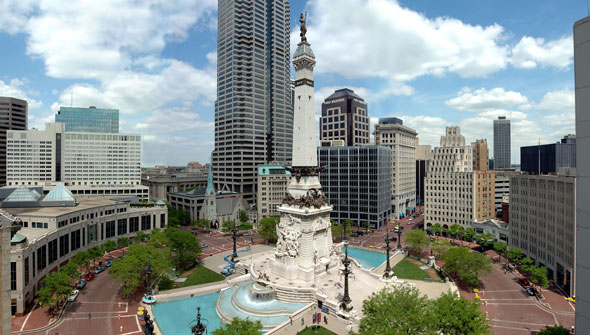Soldiers and Sailors Monument
Monument Circle

The Soldiers and Sailors Monument is the physical and spiritual heart of Indianapolis. But in a city where so much was planned, this was not what was supposed to go on the site at all. Indianapolis was originally planned by Alexander Ralston, an assistant to Washington, DC designer Pierre L'Enfant, as a grand capital city. He put a circle at the intersection of Meridian and Market Streets, intending for it to be the location of the Governor's Mansion, and it was originally known as the Governor's Circle.
As you might suspect for such a busy and public location, no governor ever resided on the spot. After the Civil War, the state decided to erect a monument to those who fought on it. An international competition resulted in the selection of German architect Bruno Schmitz in 1887. This is only work by Schmitz outside of Germany or Switzerland.
Construction began in 1888. The state held further competitions to design statuary and other aspects of the monument, but began to run into troubles as Chicago lured away many prominent designers to the World's Columbian Exhibition. The state eventually turned back to Schmitz and Austrian Rudolph Schwarz to finish the designs. The Monument was finally completed in 1901.
The Monument is 284 feet tall. For many years, it was illegal to erect any building in Indianapolis taller than the Monument, and height restrictions are still in effect on the Circle itself. The basement contains a Civil War Museum. The top is crowned with a statue of Victory, more commonly referred to as Miss Indiana. You can visit an observatory at the top with an elevator ride and walk up a narrow staircase.
Monument Circle is an important civic gathering place. During warm summer weather, office workers lunch on its steps next to the fountains. At holiday season, lights are strung from the Monument to create what the city bills as the “World's Largest Christmas Tree”. The Circle is frequently home to celebrations and protests. Many historic and prominent buildings line the circle, including Christ Church Cathedral, the Circle Theater, and the Columbia Club.
The site of the Monument is one of two parcels that the state constitution forbids the government to dispose of. Military Park on the west side of downtown is the other.
